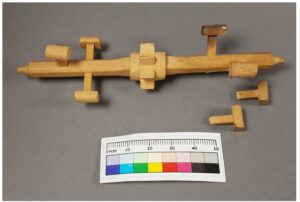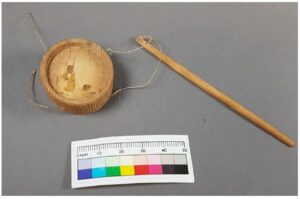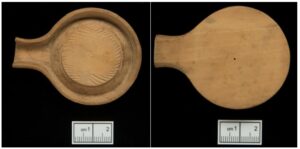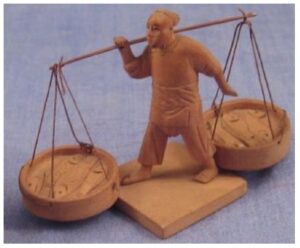July ’20
Wooden Miniatures
July’s ‘Object of the Month’ is a set of wooden miniatures from the Oriental Museum collections.
This set of objects is part of a larger collection of wooden miniatures from China owned by the Oriental Museum, Durham. This collection includes miniatures depicting a variety of practices from agricultural labour and rickshaw driving to drug use and execution scenes. It is believed that they would have been sold in China as ‘cultural souvenirs’, however, as souvenirs, these objects are ethically problematic as they represent Chinese people as dangerous and savage or otherwise subservient.

The first object is part of a grain mill. A grinding stone would sit on the central platform and flour would be released into the groove and collected at the lip. The grinding stone is missing but it almost certainly originally had one because there is a small hole in the centre of the platform where previously something had been attached. These types of mills have been used for hundreds of years and are still used today. They can be large, operated by animals, or small and hand operated.

The second object is part of a Chinese irrigation tool known as a ‘dragon bone water lift’. The pedals are turned by foot, and this turns the central cog attached to a water lift. The tapered ends are for slotting into the rig.

The figure was not part of the original set of objects received for conservation, however, upon examination it seems likely to be part of the irrigation tool miniature. The position of the legs and feet match the distance between the pedals, and the broken pins in the feet and on the pedals match up, further suggesting they are part of the same object.

The third object depicts a basket of fish suspended from a carrying pole. The carrying of a pole from which to suspend cargo is a traditional method used in Chinese agricultural communities. Comparable figures suggested that there should be two baskets, one on each end of the pole; this is further evidenced by there being a notch at the other end of the pole to hold thread. A small hole in the centre of the pole indicates where the pole was likely attached to a human figure carrying the baskets. Adhesive in the basket implies something used to be stuck inside; likely a carved fish. One of the more common uses for these poles is the carrying of fish, and there are pencil marks in the basket that resemble a fish, possibly made during manufacture to show where the fish should be adhered.
Condition
- Dust and dirt on the surface of all objects
- Signs of corrosion on the iron pins of the water lift components
- Broken pedals on the water lift
- Yellow, brittle adhesive on the basket
- Snapped thread on the basket
- Missing pieces from all objects
Conservation

The dirt was initially brushed with a soft bristled brush into the nozzle of a Museum Vac at low suction – the nozzle was covered in mesh to catch any dislodged pieces. This proved adequate for the water lift but, due to the finer details on the other three objects, a stiff, bristled brush was employed instead.
Basket
The old adhesive on the basket appeared to be cellulose nitrate, and so acetone was applied using a cotton swab to remove it from the surface of the objects.

The broken strings on the fish basket were degraded and unsuitable for carrying the weight of the basket. To prevent further stress to the strings, nylon thread was pushed through the existing holes and tied to the pole and the original strings adhered to them with a small amount of PVA.
This object had the most evidence to support an accurate reconstruction, and so a replica basket was created to mimic the original. A mould was made of the original basket as this would pick up the fine detail and allow an accurate replica to be made.

In order to not put unbalanced stress on the pole, the replica had to be as close to the weight of the original basket as possible. This was done by allowing a thin layer of the replica to set, before placing a small plastic cup into the mould and pouring the remaining resin around it. The cup was removed after the resin had set, creating a hollow replica. This was filed down until its weight matched the original to within 0.1g.
The replica was colour matched to the original and attached to the pole using nylon thread. The fish were not reconstructed as there was no clear evidence for how they should have looked.
Water Lift

The broken pedals on the water lift were reattached using neutral pH adhesive, as this had been used successfully on wood in the past.
Replication was done for the missing pedal as this was a clearly evidenced missing part. The pedal was made using balsa wood, the replica needed slotting into the water lift and, due to this close proximity to the original object, it was important that the replica material react similarly to environmental factors. While the stem was easy to carve, the shape of the head was difficult to achieve and so a Trylon polyester resin replica was made using a Siligum cast of an existing pedal.
Although it is clear from the alignment of the pins where the figure was attached to the water lift, repining would involve the highly interventive removal of the existing pins to accommodate new ones. Moreover, the amount of actual contact space between the two models was far too small to safely adhere them together. It was decided that the two objects should remain separate.

The function of the water lift and its operator could not be communicated in its current form, however, there was not enough evidence of its original form to support the creation of additional parts. In order to display to museum visitors how the object would have worked, a stand was made to hold them in a position that communicated their purpose, while being both physically and cisually separate from the original objects. The stand was made to resemble the constructs that exist around real water lifts.
Stay tuned for next month’s object!
